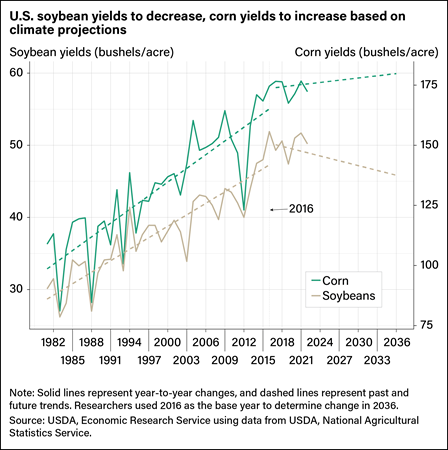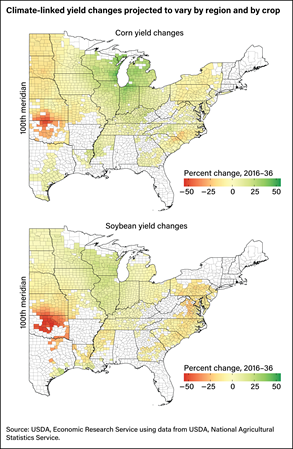ERS Research Models Future Effects of Climate Change on Corn and Soybean Yields, Production, and Exports

Highlights:
-
A recent study by USDA’s Economic Research Service (ERS) modeled how climate-linked changes in temperatures and precipitation might affect future corn and soybean yields and what that would mean for markets and trade through the middle of the next decade.
-
U.S. corn yields were estimated to increase, but at a historically slow rate, and a decline was projected for soybean yields by 2036.
-
During the same period, corn exports were expected to rise slightly, and soybean exports were expected to fall more than 1 percent for a total decrease for the two crops of as much as $256 million by 2036.
Since 1970, U.S. corn and soybean yields have doubled, but damaging effects of extreme weather events such as droughts and floods have slowed yield gains and interrupted decades of rapidly rising agricultural productivity. Such extreme weather events are expected to become more common, according to the United Nations’ Intergovernmental Panel on Climate Change (IPCC). A recent study by USDA’s Economic Research Service (ERS) modeled how climate-linked changes in temperatures and precipitation, especially east of the 100th meridian where farms are predominantly rain-fed, might affect future U.S. corn and soybean yields and what that would mean for markets and trade through the middle of the next decade. Using 2016 as a base year, the model estimated an increase in U.S. corn yields but a decrease in soybean yields by the year of 2036. These changes also would affect exports of U.S. corn and soybeans. In the model, corn exports are projected to increase 0.36 percent by 2036, compared with 2016, while soybean exports drop 1.17 percent for a total decrease for the two crops of as much as $256 million by 2036.
U.S. corn yields were estimated to increase 3.1 percent by 2036, representing historically slow yield growth compared with previous decades. In contrast, soybean yields were projected to reverse their multidecade growth trend and decrease 3.0 percent. With the yield changes, the use of land in corn and soybean production also was expected to shift. U.S. corn producers were expected to plant fewer acres of corn, because of increased yields, for an estimated 0.11 percent net increase in projected U.S. corn production by 2036. Soybean producers, however, were projected to increase acreage, offsetting the impact of the expected yield decrease and resulting in a net production increase of about 1 percent by 2036.
Some States were expected to feel the effects of climate change on yields more profoundly than others. Declines in productivity were concentrated in central States, where corn and soybean yields were projected to decrease by 14.5 percent and 7.1 percent, respectively. Climate-linked yield declines in Kansas, Nebraska, Oklahoma, and North and South Dakota were the most extreme, projected as great as 25.4 percent for corn and 43.4 percent for soybeans. Balancing those expectations, yields were expected to increase in four States in the Corn Belt, the region that produces about 80 percent of U.S. corn and soybeans. On average, yields in Illinois, Missouri, Iowa, and Wisconsin were projected to increase 5.7 percent for corn and 1.2 percent for soybeans by 2036. Outside the Corn Belt, small, mostly offsetting yield losses and gains for both crops were projected.
The yield results also have implications for U.S. exports of corn and soybeans. By 2036, exports of corn were projected to increase by the equivalent of $63 million (in 2016 dollars), with additional shipments to China ($18 million), Mexico ($9 million), Japan ($4 million), South Korea ($4 million), and other countries ($28 million). Exports of soybeans, however, were projected to decline by or $319 million across all trading partners. A $171 million reduction in soybean exports to China, where U.S. market share of soybean trade has retracted in recent years, was the largest projected decrease.
The United States contributed more to the global corn supply than China, India, and Russia combined in 2020. U.S. soybean production was exceeded only by Brazil’s harvest that year, making the United States a top producer and exporter of corn and soybeans.
Estimating Market Implications From Corn and Soybean Yields Under Climate Change in the United States, by Jayson Beckman, Maros Ivanic, and Noé J. Nava, ERS, October 2023
The Economic Impacts of Retaliatory Tariffs on U.S. Agriculture, by Stephen Morgan, Shawn Arita, Jayson Beckman, Saquib Ahsan, Dylan Russell, Philip Jarrell, and Bart Kenner, ERS, January 2022
Declining Crop Prices, Rising Production and Exports Highlight U.S. Agricultural Projections to 2032, by Brian Williams, Erik Dohlman, and Matthew Miller, USDA, Economic Research Service, February 2023



